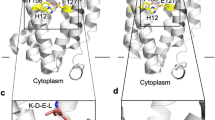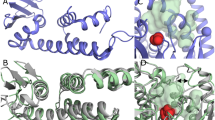Abstract
Proteins secreted by prokaryotic cells are synthesized as precursors containing an amino-terminal extension sequence or signal peptide1. Although these signal peptides share little primary sequence homology, recent studies suggest that they function via common pathways during the transport process2 and that a common element may reside in their secondary structural characteristics3–7. We are investigating the role of an idealized hydrophobic sequence with high potential for α-helix formation in the Escherichia coli alkaline phosphatase signal peptide. Here, amino-acid substitutions were made using site-directed mutagenesis to produce a mutant signal sequence containing nine consecutive leucine residues in the hydrophobic core segment. Transport studies with this mutant precursor indicate that mature alkaline phosphatase is correctly targeted to the E. coli periplasm and that processing of the precursor to the mature form of the enzyme is extremely rapid. In contrast, processing is slowed when the mutant signal sequence is lengthened by the insertion of five additional leucine residues and one serine.
This is a preview of subscription content, access via your institution
Access options
Subscribe to this journal
Receive 51 print issues and online access
$199.00 per year
only $3.90 per issue
Buy this article
- Purchase on Springer Link
- Instant access to full article PDF
Prices may be subject to local taxes which are calculated during checkout
Similar content being viewed by others
References
Michaelis, S. & Beckwith, J. A. Rev. Microbiol. 36, 435–465 (1982).
Bankaitis, V. A. & Bassford, P. J. Jr J. biol Chem. 259, 12193–12200 (1984).
Engleman, D. M. & Steitz, T. A. Cell 23, 411–422 (1981).
Reddy, G. L. & Nagaraj, R. Biochim. biophys. Acta 831, 340–346 (1985).
Bankaitis, V. A., Rasmuseen, B. A. & Bassford, P. J. Jr Cell 37, 243–252 (1984).
Briggs, M. S. & Gierasch, L. M. Biochemistry 23, 3111–3114 (1984).
Shinnar, A. E. & Kaiser, E. T. J. Am. chem. Soc. 106, 5006–5007 (1984).
Von Heijne, G. J. Mol. Biol. 184, 99–105 (1985).
Emr, S. D. & Silhavy, T. J. Proc. natn. Acad. Sci. U.S.A. 80, 4599–4603 (1983).
Arfmann, H.-A., Labitzke, R. & Wagner, K. G. Biopolymers 16, 1815–1826 (1977).
Chou, P. Y. & Fasman, G. D. A. Rev. Biochem. 47, 251–276 (1978).
Kaiser, E. T. & Kézdy, F. J. Science 223, 249–255 (1984).
Inouye, H., Michaelis, S., Wright, A. & Beckwith, J. J. Bact. 146, 668–675 (1981).
Zoller, M. J. & Smith, M. DNA 3, 479–485 (1984).
Sanger, F., Nicklen, S. & Coulson, A. R. Proc. natn. Acad. Sci. U.S.A. 74, 5463–5467 (1977).
Ghosh, S. S., Bock, S. C., Rokita, S. E. & Kaiser, E. T. Science 231, 145–148 (1986).
Vlasuk, G. P., Inouye, S. & Inouye, M. J. biol. Chem. 259, 6195–6200 (1984).
Zuker, M. & Sankoff, D. Bull. math. Biol. 46, 591–621 (1984).
Iserentant, D. & Fiers, W. Gene 9, 1–12 (1980).
Schwartz, M., Roa, M. & Débarbouillé, M. Proc. natn. Acad. Sci. U.S.A. 78, 2937–2941 (1981).
Neidhardt, F., Bloch, P. L. & Smith, D. F. J. Bact. 119, 736–747 (1974).
Ito, K., Bassford, P. J. Jr & Beckwith, J. Cell 24, 707–717 (1981).
Oliver, D. B. & Beckwith, J. Cell 30, 311–319 (1982).
Laemmli, U. K. Nature 277, 680–685 (1970).
Author information
Authors and Affiliations
Rights and permissions
About this article
Cite this article
Kendall, D., Bock, S. & Kaiser, E. Idealization of the hydrophobic segment of the alkaline phosphatase signal peptide. Nature 321, 706–708 (1986). https://doi.org/10.1038/321706a0
Received:
Accepted:
Issue Date:
DOI: https://doi.org/10.1038/321706a0
This article is cited by
-
The Principles of Protein Targeting and Transport Across Cell Membranes
The Protein Journal (2019)
-
Site-saturation mutagenesis of mutant l-asparaginase II signal peptide hydrophobic region for improved excretion of cyclodextrin glucanotransferase
Journal of Industrial Microbiology and Biotechnology (2017)
-
Enhancing full-length antibody production by signal peptide engineering
Microbial Cell Factories (2016)
-
Recognition of a signal peptide by the signal recognition particle
Nature (2010)
-
Characterization of the secretion efficiency of a plant signal peptide in Bacillus subtilis
Molecular and General Genetics MGG (1992)
Comments
By submitting a comment you agree to abide by our Terms and Community Guidelines. If you find something abusive or that does not comply with our terms or guidelines please flag it as inappropriate.



